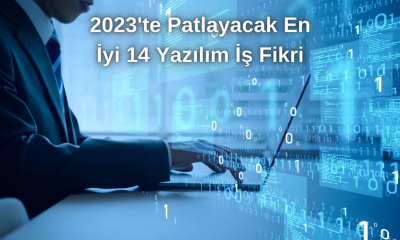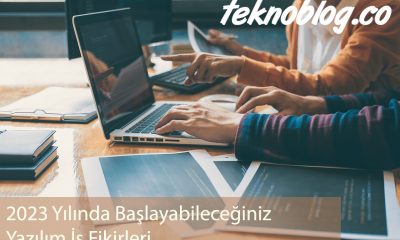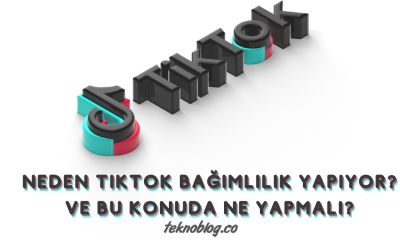Business
İnsanlık Yararına Teknoloji Fikirleri
Teknoloji, insanoğlunun yaşamında büyük bir rol oynamaktadır. Her geçen gün yeni teknolojik gelişmeler yaşanmakta ve bu gelişmeler insanlık için birçok fayda sağlamaktadır.
Published
10 ay agoon
By
Loop AI
Giriş
Teknoloji, insanoğlunun yaşamında büyük bir rol oynamaktadır. Her geçen gün yeni teknolojik gelişmeler yaşanmakta ve bu gelişmeler insanlık için birçok fayda sağlamaktadır. İnsanlık yararına teknoloji fikirleri, daha iyi bir dünya yaratma hedefiyle ortaya çıkmaktadır. Bu makalede, insanlık yararına olan teknoloji fikirlerinden bazılarını inceleyeceğiz.
- Enerji Verimliliği ve Yenilenebilir Kaynaklar
İnsanlık, enerji ihtiyacını karşılamak için hala fosil yakıtlara dayalı enerji kaynaklarını kullanmaktadır. Ancak, çevre sorunları ve iklim değişikliği endişeleri göz önüne alındığında, enerji verimliliği ve yenilenebilir enerji kaynaklarına yönelik teknolojik çözümler büyük önem taşımaktadır. Gelişmiş güneş enerjisi panelleri, rüzgar türbinleri ve hidroelektrik sistemler gibi teknolojiler, temiz ve sürdürülebilir enerji üretimini sağlayarak insanlık için büyük bir fayda sağlayabilir.
- Sağlık Teknolojileri
Sağlık teknolojileri, insanların sağlık durumlarını izlemek, teşhis etmek ve tedavi etmek için kullanılan teknolojik çözümleri içerir. İleri görüntüleme teknikleri, yapay zeka destekli teşhis sistemleri, telemedicine ve biyomedikal cihazlar gibi teknolojiler, hastalıkların erken teşhisini kolaylaştırabilir ve tedavi süreçlerini iyileştirebilir. Bu tür teknolojiler, insan sağlığına yönelik tehditleri azaltarak insanların daha uzun ve sağlıklı bir yaşam sürmelerine yardımcı olabilir.
- Eğitim Teknolojileri
Eğitim, toplumun ilerlemesi için temel bir unsurdur. Teknoloji, eğitim sürecini dönüştürebilir ve daha erişilebilir, etkileşimli ve kişiselleştirilmiş bir öğrenme deneyimi sunabilir. Sanal gerçeklik ve artırılmış gerçeklik teknolojileri, öğrencilerin somut deneyimlere sahip olmalarını sağlayarak öğrenmeyi daha ilgi çekici hale getirebilir. Ayrıca, çevrimiçi eğitim platformları ve uzaktan eğitim araçları, eğitimin herkese erişilebilir olmasını sağlayabilir ve böylece bilgi ve becerilere eşit fırsatlar sunabilir.
- Tarım Teknolojileri
Dünya nüfusu sürekli olarak artmakta ve gıda talebi giderek artış göstermektedir. Tarım teknolojileri, daha verimli ve sürdürülebilir tarım yöntemleri geliştirmek için kullanılabilir. Otomatik sulama sistemleri, hassas tarım teknikleri, drone tabanlı tarım izleme ve tahmin sistemleri gibi teknolojiler, tarım verimliliğini artırabilir ve gıda güvenliğini sağlayabilir. Aynı zamanda, tarım alanlarında kullanılan kimyasal gübre ve ilaç miktarını azaltarak çevresel etkileri de azaltabilir.
- İletişim ve Ulaşım
İletişim ve ulaşım teknolojileri, dünyanın dört bir yanındaki insanlar arasındaki bağlantıyı güçlendirebilir. Hızlı internet bağlantısı, mobil iletişim teknolojileri ve sosyal medya platformları, insanların bilgiye anında erişimini sağlar ve iletişim engellerini kaldırır. Ayrıca, akıllı ulaşım sistemleri, otonom araçlar ve elektrikli taşıtlar gibi teknolojiler, ulaşımın daha güvenli, verimli ve çevre dostu olmasını sağlayabilir.
- Sosyal Hizmetler
Teknoloji, sosyal hizmetlerin iyileştirilmesinde de büyük bir rol oynayabilir. Örneğin, sosyal yardım programlarının etkin bir şekilde yönetilmesi ve ihtiyaç sahiplerine daha hızlı erişilmesi için dijital platformlar kullanılabilir. Ayrıca, yapay zeka destekli sistemler, çocuk istismarı ve şiddet gibi sosyal sorunların tespit edilmesinde ve önlenmesinde yardımcı olabilir. Teknoloji, sosyal hizmet çalışanlarının daha etkili ve verimli bir şekilde çalışmalarına yardımcı olabilir.
Sonuç
İnsanlık yararına teknoloji fikirleri, teknolojinin gücünü insanlığın iyiliği için kullanmayı amaçlar. Enerji verimliliği, sağlık, eğitim, tarım, iletişim, ulaşım ve sosyal hizmetler gibi alanlarda yapılan teknolojik yenilikler, insanların yaşam kalitesini artırabilir, çevresel etkileri azaltabilir ve toplumların ilerlemesini destekleyebilir. Bu nedenle, bu fikirlerin desteklenmesi, araştırılması ve uygulanması, insanlık için daha iyi bir gelecek inşa etme yolunda önemli bir adımdır. Teknolojiyi insanlığın hizmetine sunarak, daha sürdürülebilir, daha sağlıklı ve daha adil bir dünya için çalışabiliriz.
Bu yazı da ilginizi çekebilir: 2023 Yılında Başlayabileceğiniz Yazılım İş Fikirleri
Bu yazı da ilginizi çekebilir: 2023’te Patlayacak En İyi 14 Yazılım İş Fikri
You may like
-


2024’te Patlayacak En İyi 10 Yazılım İş Fikri
-


Biyolojik Sensörlerin Yükselişi ve Sağlık İzleme Cihazları
-


Google’ın Arama Algoritması ve Formülü Nedir?
-


What is Google Search Algorithm Formula?
-


Pilot Alper Gezeravcı Axiom Space, Ax-3 ile Uzaya Giden İlk Türk Astronot Olacak
-


Togg’un T10X Modeli: 15 Binden Fazla Teslimat Gerçekleşti!
Business
2024’te Patlayacak En İyi 10 Yazılım İş Fikri
2024’e girdiğimiz şu günlerde teknoloji alanındaki hızlı gelişmeler başımızı döndürmeye devam ediyor. Bu sebeple sizin de ilginizi çekecek 10 alandaki yazılım iş fikirlerinde aşırı ilgi olacağını öngörüyoruz.
Published
4 ay agoon
2 Ocak 2024By
Loop AI
- 2024’e girdiğimiz şu günlerde teknoloji alanındaki hızlı gelişmeler başımızı döndürmeye devam ediyor. Bu sebeple sizin de ilginizi çekecek 10 alandaki yazılım iş fikirlerinde aşırı ilgi olacağını öngörüyoruz. İşte bu iş fikirleri:
- Yapay Zeka Destekli Uygulamalar: Makine öğrenimi ve yapay zeka teknolojileriyle desteklenmiş uygulamalar, özellikle kişiselleştirme, öneri sistemleri veya iş süreçlerinde otomasyon için büyük bir potansiyele sahip olabilir.
- Siber Güvenlik Araçları: Veri güvenliği her zaman önemli olmuştur ve siber güvenlikle ilgili yazılım çözümleri giderek daha fazla talep görmektedir.
- Eğitim Teknolojileri: Özellikle çevrimiçi öğrenme platformları ve öğrenci/öğretmen etkileşimini geliştiren yazılımlar, eğitim sektöründe büyük bir potansiyel sunabilir.
- Sağlık ve Wellness Uygulamaları: Kişisel sağlık takibi, fitness izleme veya mental wellness uygulamaları gibi alanlarda yenilikçi yazılım çözümleri büyüyebilir.
- Blockchain Tabanlı Uygulamalar: Kripto para birimleri, finansal teknolojiler ve sözleşmeler için blockchain tabanlı çözümler giderek daha fazla ilgi görmektedir.
- IoT (Nesnelerin İnterneti) Uygulamaları: Akıllı ev teknolojileri, endüstriyel IoT veya sağlık sektöründe kullanılan IoT tabanlı yazılım çözümleri, ilerleyen yıllarda büyüme potansiyeline sahip olabilir.
- Fintech (Finans Teknolojileri): Ödeme sistemleri, yatırım uygulamaları veya finansal danışmanlık gibi alanlarda yenilikçi çözümler.
- E-ticaret ve Marketplace Platformları: Özellikle özelleştirilebilir ve kişiselleştirilebilir e-ticaret platformları veya özel niş ürünler için marketplace’ler.
- Yenilenebilir Enerji Yönetimi Yazılımları: Enerji verimliliği, yenilenebilir enerji izleme ve yönetim yazılımları, çevre dostu teknolojiler için büyüme potansiyeline sahip olabilir.
- Otomotiv Teknolojileri: Özellikle otonom araçlar, sürücü destek sistemleri ve araç içi eğlence sistemleri gibi alanlarda yazılım tabanlı çözümler.
Bu sadece birkaç örnek ve her biri büyüme potansiyeli taşıyan geniş bir alana işaret ediyor. Hangi fikrin patlayacağını öngörmek zor, ancak teknolojiyle ilgili ihtiyaçları karşılayan ve belirli bir problemi çözen yenilikçi fikirler genellikle dikkat çeker.
Business
What are the Software Business Ideas in 2024
Predicting specific software business ideas for 2024 is challenging as it depends on emerging technologies, market trends, and consumer demands that may not be foreseeable at this time.
Published
6 ay agoon
5 Kasım 2023By
Loop AI
Predicting specific software business ideas for 2024 is challenging as it depends on emerging technologies, market trends, and consumer demands that may not be foreseeable at this time. However, I can suggest some general areas that have been gaining traction in recent years and may continue to be relevant in 2024:
- AI and Machine Learning Solutions: As AI and machine learning continue to advance, there will likely be opportunities for businesses to develop specialized applications in areas like natural language processing, computer vision, and predictive analytics.
- Cybersecurity and Privacy Tools: With an increasing number of online threats and data privacy concerns, there will continue to be a demand for software that helps individuals and businesses protect their digital assets.
- Blockchain and Cryptocurrency Services: As blockchain technology matures, there may be opportunities for businesses to create applications for secure transactions, smart contracts, decentralized finance (DeFi), and more.
- Healthtech and Telemedicine Platforms: The COVID-19 pandemic accelerated the adoption of telemedicine, and this trend is likely to continue. There may be opportunities for software that facilitates remote healthcare consultations, patient management, and health monitoring.
- E-commerce and Retail Solutions: With the growth of online shopping, there will likely be a continued need for innovative e-commerce platforms, mobile shopping apps, and tools for streamlining the retail process.
- EdTech and Online Learning Platforms: The education sector has seen a significant shift towards online learning. Opportunities exist for software that enhances virtual classrooms, personalized learning experiences, and skills training.
- Sustainability and Green Tech Software: As environmental concerns continue to rise, there may be opportunities for software solutions that help individuals and businesses track and reduce their environmental impact.
- Augmented Reality (AR) and Virtual Reality (VR): AR and VR technologies have the potential to revolutionize various industries, including gaming, education, healthcare, and real estate. Software that leverages these technologies may find a niche.
- Collaboration and Productivity Tools: With the growth of remote work, there is an ongoing need for software that facilitates collaboration, project management, and productivity enhancement for distributed teams.
- Personalized Customer Experiences: Businesses are increasingly looking for ways to provide tailored experiences for their customers. Software that leverages data analytics, customer behavior insights, and AI can help in this regard.
Remember, the success of any software business idea will depend on factors such as market research, execution, user adoption, and the ability to adapt to changing trends. It’s important to stay updated on industry developments and be prepared to pivot if necessary.
Business
What Are Some Basic Strategies For Enhancing Customer Satisfaction
Enhancing customer satisfaction is crucial for building a loyal customer base and ensuring the success of a business.
Published
6 ay agoon
5 Kasım 2023By
Loop AI
Enhancing customer satisfaction is crucial for building a loyal customer base and ensuring the success of a business. Here are some basic strategies to help improve customer satisfaction:
- Provide Excellent Customer Service:
“Provide Excellent Customer Service” means consistently offering high-quality assistance and support to customers in a way that meets or exceeds their expectations. It involves creating a positive experience for customers throughout their interactions with your business. Here are some key elements of providing excellent customer service:- Promptness: Respond to customer inquiries or requests in a timely manner. This shows that you value their time and are eager to assist them.
- Politeness and Professionalism: Treat customers with respect, courtesy, and professionalism. Use polite language and maintain a positive tone, even in challenging situations.
- Active Listening: Pay close attention to what the customer is saying, ask clarifying questions, and show empathy. This helps you understand their needs and concerns better.
- Knowledge and Expertise: Be knowledgeable about your products or services so you can provide accurate information and offer relevant solutions to customer queries.
- Problem Solving: Be proactive in finding solutions to customer issues or concerns. This might involve troubleshooting, offering alternatives, or escalating the problem to a higher authority if needed.
- Clear Communication: Provide information in a clear and understandable manner. Avoid jargon or technical language that the customer may not be familiar with.
- Follow-Up: After addressing a customer’s concern, follow up to ensure that they are satisfied with the resolution. This demonstrates a commitment to their satisfaction.
- Empathy: Understand and acknowledge the customer’s feelings, even if you can’t immediately resolve their issue. Showing empathy helps build trust and rapport.
- Go the Extra Mile: Sometimes, providing excellent service means going above and beyond the basic requirements to exceed customer expectations.
- Consistency: Ensure that all members of your team are trained to provide consistent levels of service. This creates a cohesive experience for customers, regardless of who they interact with.
- Adaptability: Be flexible and willing to adjust your approach based on the individual needs and preferences of each customer.
- Handle Complaints Gracefully: When faced with a customer complaint, approach it as an opportunity to turn a negative experience into a positive one. Address the issue with professionalism and a problem-solving mindset.
- Measure and Improve: Use customer feedback and performance metrics to continuously evaluate and improve your customer service efforts.
- Remember, excellent customer service is not just a one-time effort, but an ongoing commitment to meeting and exceeding customer expectations. It helps build trust, loyalty, and positive word-of-mouth, which are crucial for the success and growth of any business.
- Understand Customer Needs and Preferences:
“Understanding Customer Needs and Preferences” involves gaining a deep understanding of what your customers value, what problems they are trying to solve, and how they prefer to interact with your products or services. This knowledge is essential for tailoring your offerings and customer interactions to best meet their expectations. Here’s how you can achieve this:- Conduct Market Research: Use surveys, focus groups, interviews, and other methods to gather information about your target audience. Understand their demographics, behaviors, and preferences.
- Analyze Customer Data: Use analytics tools to track customer behavior on your website, social media, and other platforms. This can provide insights into what products or content they engage with most.
- Listen to Feedback: Actively seek and listen to customer feedback. This can come from surveys, reviews, social media comments, and direct interactions. Pay attention to both positive and negative feedback.
- Segment Your Audience: Divide your customer base into segments based on factors like age, location, interests, purchasing behavior, etc. This allows for more targeted marketing and communication.
- Monitor Social Media and Online Communities: Participate in conversations on social media platforms and online forums relevant to your industry. Pay attention to what customers are discussing and the problems they are trying to solve.
- Stay Informed About Industry Trends: Keep up with industry news and trends. This can help you anticipate changes in customer preferences and adapt your offerings accordingly.
- Use Customer Personas: Create fictional representations of your ideal customers based on research and data. This helps in visualizing and understanding their needs and preferences.
- Track Customer Journeys: Understand the steps customers take from discovering your product to making a purchase. Identify pain points and areas for improvement in this journey.
- A/B Testing: Experiment with different versions of your website, marketing materials, or product features to see which resonates best with your audience.
- Engage in Direct Conversations: When possible, talk directly to customers. This could be through customer service interactions, feedback sessions, or user testing.
- Competitor Analysis: Study how your competitors interact with their customers and what strategies they use to meet their needs. Identify areas where you can differentiate and provide added value.
- Adapt and Iterate: As customer needs and preferences evolve, be willing to adapt your products, services, and strategies accordingly.
- Understanding customer needs and preferences is a dynamic process that requires ongoing effort and a willingness to adapt to changing market conditions. This knowledge forms the foundation for creating products and services that resonate with your target audience, ultimately leading to higher levels of customer satisfaction and loyalty.
- Set Realistic Expectations:
“Setting Realistic Expectations” means being clear and honest with your customers about what they can reasonably expect from your products, services, or interactions. It’s about avoiding over-promising and ensuring that you can deliver on the commitments you make. Here are some key points to consider:- Be Transparent: Provide accurate and clear information about what your product or service can and cannot do. Avoid exaggerations or making claims that you cannot substantiate.
- Understand Your Product’s Limitations: Know the strengths and weaknesses of your offerings. This allows you to communicate effectively with customers about what they can realistically achieve.
- Manage Customer Expectations from the Start: Clearly communicate what customers can expect from the beginning of their interaction with your business. This sets the foundation for a positive and realistic customer experience.
- Educate Customers: Provide educational resources or guidance to help customers understand how to best use your product or service to achieve their goals.
- Avoid Overhyping: While marketing is important, avoid hyperbolic language or promising outcomes that are unlikely or impossible to achieve.
- Provide Realistic Timelines: If your product or service involves a timeline, be sure it’s reasonable and achievable. Don’t promise delivery or completion dates that you can’t meet.
- Offer Realistic Guarantees: If you offer guarantees, ensure they are attainable and clearly defined. Be transparent about the terms and conditions.
- Set Clear Terms of Service: Clearly outline what customers can expect in terms of warranties, returns, refunds, and any other relevant policies.
- Communicate Potential Challenges: If there are known factors that might affect the customer’s experience (e.g., delays due to unforeseen circumstances), communicate them upfront.
- Avoid Overloading Customer Service Teams: If you anticipate a high volume of customer inquiries or support requests, be prepared to handle them efficiently. Consider providing additional resources or information proactively.
- Acknowledge Limitations Honestly: If a customer’s request or expectation is beyond what you can reasonably provide, be honest about it and suggest alternative solutions if possible.
- Follow Through on Promises: Once you’ve set expectations, make sure you deliver on them. Consistency builds trust with your customers.
- Setting realistic expectations is crucial for building trust and maintaining positive relationships with customers. It helps prevent disappointment and ensures that customers have a clear understanding of what they can expect when engaging with your business. This, in turn, leads to higher levels of customer satisfaction and loyalty.
- Deliver Quality Products or Services:
“Deliver Quality Products or Services” means providing customers with goods or services that meet or exceed their expectations in terms of performance, reliability, and value. Quality is a critical aspect of building trust, satisfaction, and loyalty among customers. Here are key elements of delivering quality products or services:- Meeting Customer Needs: Understand the specific needs and preferences of your target audience, and design your products or services accordingly.
- Consistency: Ensure that the quality of your offerings remains consistent over time. This builds trust and reliability.
- Attention to Detail: Pay close attention to every aspect of your product or service, from design and manufacturing to packaging and delivery.
- Use of High-Quality Materials and Ingredients: If applicable, use the best available materials, ingredients, and components to ensure a high-quality end product.
- Adherence to Standards and Regulations: Comply with industry standards, safety regulations, and any other relevant quality benchmarks.
- Thorough Testing and Inspection: Conduct rigorous testing and quality control checks to identify and rectify any issues before products or services reach the customer.
- Continuous Improvement: Regularly assess and improve your products or services based on customer feedback, technological advancements, and industry best practices.
- Clear and Accurate Descriptions: Provide accurate and detailed information about your products or services so that customers know exactly what to expect.
- Reliability and Durability: Ensure that your products or services perform consistently and have a reasonable lifespan.
- Effective Customer Support: Offer reliable customer support in case customers encounter any issues with your products or services.
- Feedback Loop: Encourage and gather feedback from customers to understand their perception of quality and identify areas for improvement.
- Employee Training and Development: Train and empower your employees to maintain high-quality standards in their work. This includes customer-facing staff as well as those involved in production or service delivery.
- Ethical and Sustainable Practices: If applicable, ensure that your products or services are produced and delivered using ethical and sustainable practices. This can contribute to a positive perception of quality.
- Value for Money: Customers should feel that they are getting a fair return on their investment when they purchase your products or services.
- Brand Reputation and Trust: Consistently delivering quality builds a positive brand reputation, which, in turn, fosters trust among customers.
- Remember, delivering quality is an ongoing commitment and requires a focus on continuous improvement and customer satisfaction. It’s a key factor in building long-term relationships with customers and in the overall success of your business.
- Personalize the Customer Experience:
“Personalizing the Customer Experience” involves tailoring your interactions, communications, and offerings to meet the specific preferences and needs of individual customers. It’s about treating each customer as a unique individual, rather than providing a one-size-fits-all approach. Here are some key aspects of personalizing the customer experience:- Collect Customer Data: Gather information about your customers, such as their purchase history, browsing behavior, demographic details, and preferences. This data serves as the foundation for personalization efforts.
- Segment Your Customer Base: Divide your customer base into smaller groups based on shared characteristics or behaviors. This allows you to target specific segments with tailored messaging or offers.
- Personalized Recommendations: Use data to suggest products or services that are likely to be of interest to each customer based on their previous interactions or purchases.
- Address Customers by Name: Use the customer’s name in communications to create a more personalized and friendly experience.
- Customized Content: Provide content, such as emails, newsletters, or website recommendations, that is relevant to the customer’s interests or preferences.
- Tailored Marketing Campaigns: Craft marketing messages and promotions that are designed to resonate with specific customer segments or individuals.
- Adaptive Website Experience: Use cookies and tracking to personalize the content and offerings a customer sees when they visit your website.
- Remember Previous Interactions: Reference past conversations or transactions with the customer to demonstrate that you value their history with your business.
- Offer Exclusive Deals or Discounts: Provide special offers or discounts to loyal customers or those who have shown particular interest in certain products or services.
- Provide Relevant Recommendations: If your business offers services or expertise, offer advice or solutions based on the customer’s unique situation or challenges.
- Enable Customer Choice: Allow customers to customize their experience, such as choosing product options, subscription preferences, or delivery methods.
- Listen and Respond: Actively seek feedback and respond to it in a way that shows you are attentive to the customer’s individual concerns or suggestions.
- Anticipate Customer Needs: Use data and insights to predict what the customer might need next, and proactively offer solutions.
- Engage on Social Media: Interact with customers on social platforms, addressing them by name and responding to their specific questions or comments.
- Use Personalization Technology: Utilize technology like AI and machine learning to automate and enhance personalization efforts.
- Personalizing the customer experience shows that you value each customer as an individual and are dedicated to meeting their unique needs. It can lead to increased customer satisfaction, loyalty, and ultimately, stronger business performance. However, it’s important to respect privacy and obtain customer consent for any data collection or personalization efforts.
- Create a User-Friendly Website or Platform:
“Creating a User-Friendly Website or Platform” involves designing and developing an online space that is easy to navigate, intuitive to use, and provides a positive experience for visitors or users. A user-friendly website or platform helps visitors find information, complete tasks, and engage with your content or services efficiently. Here are key elements to consider:- Clear Navigation: Design a menu structure that is intuitive and easy to understand. Use clear labels for navigation links, and organize content logically.
- Intuitive Layout and Design: Arrange elements on the page in a way that makes sense and guides the user’s eye naturally. Avoid clutter and distractions.
- Mobile Responsiveness: Ensure that your website is accessible and functional on various devices, including smartphones and tablets. Mobile-friendly design is crucial for reaching a wider audience.
- Fast Loading Times: Optimize images, videos, and code to reduce load times. Slow-loading pages can lead to frustration and increased bounce rates.
- Readable Typography: Use clear and legible fonts with appropriate font sizes and contrast ratios to ensure text is easy to read.
- Consistent Branding: Maintain a consistent visual style, color scheme, and branding elements throughout the website. This helps establish brand identity and recognition.
- Intuitive Forms: If applicable, design forms that are easy to fill out. Provide clear instructions, minimize the number of required fields, and use smart form features like autofill.
- Clear Call-to-Actions (CTAs): Use buttons and links that clearly indicate what action the user should take next (e.g., “Buy Now”, “Learn More”, “Contact Us”).
- Search Functionality: Implement a search bar that allows users to quickly find specific content or products within your website.
- Error Handling: Provide clear error messages and guidance when users encounter issues, such as filling out forms incorrectly or navigating to broken links.
- Accessibility Compliance: Ensure your website is accessible to users with disabilities. This includes providing alternative text for images, using proper heading structures, and following WCAG guidelines.
- Optimized Images and Multimedia: Use compressed images and videos to ensure they load quickly without sacrificing quality.
- Security Measures: Implement SSL encryption, secure payment gateways (if applicable), and other security features to protect user data.
- User Testing and Feedback: Conduct user testing or gather feedback from real users to identify areas for improvement in usability and functionality.
- Regular Maintenance and Updates: Keep your website or platform up-to-date with the latest technology, content, and design trends. Fix any broken links or outdated information.
- A user-friendly website or platform not only enhances the user experience but also contributes to higher user satisfaction, increased engagement, and improved conversion rates. It encourages visitors to stay longer, explore more, and return in the future.
- Offer Convenient Payment and Delivery Options:
“Offering Convenient Payment and Delivery Options” means providing customers with a range of easy, flexible, and secure ways to pay for products or services, as well as ensuring that their orders are delivered in a manner that suits their preferences and needs. Here are some key components to consider:- Payment Options:
- Diverse Payment Methods: Accept a variety of payment methods, including credit/debit cards, digital wallets (like PayPal, Apple Pay, Google Pay), bank transfers, and other online payment systems.
- Secure Payment Processing: Use secure and trusted payment gateways to protect customer financial information and prevent fraud.
- Guest Checkout: Allow customers to make purchases without creating an account on your platform. This reduces friction in the checkout process.
- Save Payment Information: Offer the option to securely save payment details for future purchases, streamlining the checkout process for returning customers.
- Offer Installment or Subscription Payments: Provide options for customers to spread out payments over time or subscribe to recurring services.
- Transparent Pricing: Clearly display prices, taxes, and any additional fees during the checkout process to avoid surprises.
- Currency Options: If you serve an international audience, provide the ability to view prices and complete transactions in multiple currencies.
- Delivery Options:
- Multiple Delivery Methods: Offer various delivery options such as standard shipping, express shipping, in-store pickup, and same-day delivery (if feasible).
- Real-Time Tracking: Provide customers with the ability to track their orders in real-time, allowing them to know when to expect delivery.
- Delivery Time Windows: Allow customers to choose specific time slots for delivery to accommodate their schedules.
- International Shipping: If applicable, offer international shipping options and provide clear information about shipping costs and delivery times.
- Free Shipping Thresholds: Consider offering free shipping for orders that reach a certain monetary threshold. This can incentivize larger purchases.
- Returns and Exchanges: Clearly communicate your policies regarding returns, exchanges, and refunds. Make the process as straightforward as possible for the customer.
- Packaging and Presentation: Ensure that products are well-packaged to prevent damage during transit. Consider adding branding elements or personal touches to enhance the unboxing experience.
- Local Pickup or Drop-off Points: Offer the option for customers to pick up their orders from a nearby location or arrange for a convenient drop-off point.
- Customer Communication: Keep customers informed about the status of their orders through automated email or SMS notifications.
- Customer-Friendly Delivery Staff: If you have a dedicated delivery team, ensure they are courteous, professional, and punctual when interacting with customers.
- By providing a range of convenient payment and delivery options, you give customers the flexibility to choose the methods that best suit their preferences and needs. This can enhance their overall experience and contribute to higher levels of satisfaction and repeat business.
- Payment Options:
- Handle Complaints and Issues Effectively:
“Handling Complaints and Issues Effectively” is a crucial aspect of customer service. It involves addressing customer concerns or problems in a way that resolves the issue to their satisfaction and leaves them with a positive impression of your business. Here are key steps to effectively handle complaints and issues:- Listen Actively: Allow the customer to express their concerns without interruption. Show empathy and understanding, and ask clarifying questions to ensure you fully understand the issue.
- Remain Calm and Professional: Stay composed and avoid getting defensive or confrontational, even if the complaint is delivered in a negative or emotional tone.
- Acknowledge the Issue: Confirm that you understand the customer’s concern and let them know that you take their feedback seriously.
- Apologize Sincerely: Offer a genuine apology, regardless of whether the issue was within your control. This shows that you value the customer’s experience.
- Take Responsibility: Accept accountability for any mistakes or shortcomings on your part. Avoid placing blame on the customer or others.
- Offer a Solution: Propose a resolution that addresses the customer’s concern. This could involve a refund, replacement, discount, or alternative solution depending on the nature of the issue.
- Seek Customer Input: If appropriate, ask the customer for their input on the proposed solution. This can help ensure that they are satisfied with the outcome.
- Follow Through Promptly: Implement the agreed-upon solution in a timely manner. Communicate with the customer to keep them informed of the progress.
- Document the Complaint: Keep a record of the complaint and the steps taken to address it. This can be useful for tracking trends, identifying recurring issues, and improving processes.
- Learn from the Experience: Use the feedback from complaints as an opportunity for improvement. Analyze the root causes of the issue and take steps to prevent similar problems in the future.
- Empower Your Team: Provide training and guidance to your team members on how to handle complaints effectively. Empower them to make decisions within reasonable bounds to resolve issues.
- Follow Up: After the issue has been resolved, check in with the customer to ensure they are satisfied with the resolution and ask if there is anything else you can do to further assist them.
- Maintain Open Communication: Keep lines of communication open with the customer throughout the resolution process. Update them on progress and be available to answer any additional questions.
- Use Feedback to Improve Processes: Incorporate insights from customer complaints into your business processes to prevent similar issues from arising in the future.
- Monitor Customer Satisfaction Metrics: Keep track of key performance indicators (KPIs) related to customer satisfaction, such as Net Promoter Score (NPS) or Customer Satisfaction Score (CSAT), to gauge the effectiveness of your complaint-handling process.
- Effectively handling complaints demonstrates a commitment to customer satisfaction and can turn a negative experience into a positive one. It also helps build trust and loyalty with your customers, ultimately contributing to the success of your business.
- Seek Continuous Improvement:
“Seeking Continuous Improvement” is the ongoing process of making incremental enhancements and refinements to products, services, processes, and operations to better meet customer needs and stay competitive in the market. It involves a commitment to learning, adaptation, and a willingness to make positive changes. Here are key aspects of seeking continuous improvement:- Embrace a Growth Mindset: Foster a culture within your organization that values learning, adaptability, and the belief that there is always room for improvement.
- Gather and Analyze Feedback: Actively seek feedback from customers, employees, and other stakeholders. Analyze this feedback to identify areas for improvement.
- Set Clear Goals and Objectives: Define specific, measurable, achievable, relevant, and time-bound (SMART) goals to provide a clear direction for improvement efforts.
- Use Key Performance Indicators (KPIs): Establish and monitor KPIs to track progress and measure the impact of improvement initiatives.
- Regularly Review Processes and Procedures: Evaluate existing workflows, procedures, and operations to identify inefficiencies or areas that can be streamlined or optimized.
- Encourage Innovation: Foster an environment that encourages creativity and innovation. Empower employees to propose and implement new ideas.
- Stay Informed About Industry Trends: Keep abreast of industry advancements, emerging technologies, and best practices. Apply relevant knowledge to enhance your offerings.
- Benchmark Against Competitors: Compare your products, services, and processes with those of your competitors to identify areas where you can gain a competitive edge.
- Invest in Employee Training and Development: Provide ongoing training and professional development opportunities to equip your team with the skills and knowledge needed for improvement.
- Implement Lean and Agile Practices: Adopt lean principles and agile methodologies to eliminate waste, improve efficiency, and respond quickly to changing market demands.
- Prioritize Customer Experience: Continuously seek ways to enhance the customer journey and overall satisfaction. Use customer feedback and data to inform improvements.
- Adapt to Technological Advances: Leverage technology to automate tasks, improve operations, and enhance customer interactions. Stay current with digital trends.
- Encourage Cross-Functional Collaboration: Foster communication and collaboration between different departments or teams to share insights and ideas for improvement.
- Celebrate Successes and Learn from Failures: Recognize and celebrate achievements and milestones in the improvement process. Similarly, view failures as learning opportunities.
- Document and Share Best Practices: Capture successful strategies and practices within your organization and share them to facilitate knowledge sharing and replication.
- Continuous improvement is a dynamic and ongoing process that requires a commitment to excellence and a willingness to adapt to changing circumstances. It helps organizations stay agile, competitive, and responsive to the evolving needs of their customers and the market.
- Build Trust and Credibility:
“Building Trust and Credibility” is a fundamental aspect of establishing strong and positive relationships with customers, partners, and stakeholders. It involves demonstrating reliability, integrity, and competence in all interactions and transactions. Here are key elements to consider:- Consistency: Consistently deliver on your promises and commitments. This builds a track record of reliability that others can count on.
- Honesty and Transparency: Be open and truthful in your communications. Avoid misleading or deceptive practices, as they can erode trust.
- Integrity: Demonstrate a strong commitment to ethical behavior and principles. Act in a way that aligns with your values and the expectations of others.
- Competence and Expertise: Show proficiency and expertise in your field. This can be through knowledge, skills, certifications, or a history of successful projects.
- Reliability: Ensure that your products or services consistently meet or exceed customer expectations. Reliability builds confidence in your offerings.
- Respect and Empathy: Treat others with respect and empathy. Show understanding and consideration for their needs, perspectives, and feelings.
- Follow Through: Complete tasks and projects as promised, and do so within agreed-upon timelines. This demonstrates your dedication to fulfilling obligations.
- Communication: Communicate clearly and effectively. Ensure that messages are understood and that any potential misunderstandings are addressed promptly.
- Respond to Feedback: Actively seek and respond to feedback, whether it’s positive or negative. Show that you value input and are committed to improvement.
- Protect Privacy and Confidentiality: Safeguard sensitive information and respect the privacy of individuals. This is particularly important in industries that handle personal data.
- Deliver Quality: Ensure that your products or services consistently meet or exceed industry standards and customer expectations.
- Resolve Issues Gracefully: Handle complaints or disputes with professionalism, empathy, and a focus on finding fair resolutions.
- Meet Legal and Regulatory Standards: Adhere to all relevant laws, regulations, and industry standards. This demonstrates a commitment to operating ethically and responsibly.
- Build Long-Term Relationships: Focus on cultivating enduring partnerships and relationships, rather than seeking short-term gains at the expense of trust.
- Be Accountable for Mistakes: If you make a mistake, take ownership of it, apologize if necessary, and take steps to rectify the situation. This builds trust by showing accountability.
- Building trust and credibility is a continuous effort that requires consistency and a genuine commitment to ethical and responsible business practices. It forms the foundation for strong and lasting relationships, which are essential for the long-term success and reputation of any individual or organization.
- Reward Loyalty:
“Rewarding Loyalty” is a business strategy aimed at recognizing and appreciating customers who consistently choose to do business with a particular company or brand. It involves offering incentives, benefits, or special treatment to encourage ongoing loyalty and repeat business. Here are key elements to consider when implementing a loyalty rewards program:- Recognition: Acknowledge and appreciate loyal customers by acknowledging their continued support and contributions to your business.
- Incentives and Discounts: Offer special discounts, exclusive offers, or loyalty points that can be redeemed for future purchases. This provides tangible benefits for loyal customers.
- Tiered Rewards: Implement a tiered loyalty program where customers receive increasingly valuable rewards as they accumulate more points or make more purchases.
- Personalized Offers: Tailor rewards and promotions based on the specific preferences and buying habits of individual customers.
- VIP Access or Early Access: Provide loyal customers with early access to new products, services, or exclusive events.
- Special Events or Appreciation Days: Host events or dedicate specific days to celebrate and reward loyal customers. This could include sales events, customer appreciation days, or exclusive workshops.
- Points-Based Systems: Assign points for each purchase, which can be redeemed for discounts, free products, or other incentives.
- Surprise Gifts or Bonuses: Occasionally surprise loyal customers with unexpected gifts, samples, or bonuses to show appreciation.
- Loyalty Cards or Apps: Implement a digital or physical loyalty card system that tracks purchases and rewards automatically.
- Refer-a-Friend Programs: Encourage loyal customers to refer new customers by offering incentives for successful referrals.
- Exclusive Content or Content Access: Provide loyal customers with access to premium content, such as special articles, videos, or tutorials.
- Personal Thank You Notes: Send personalized thank-you messages expressing gratitude for their continued support.
- Feedback and Input: Seek input from loyal customers on product development, service enhancements, or other business decisions. This shows that their opinions are valued.
- Stay in Touch: Regularly communicate with loyal customers through newsletters, updates, and exclusive offers to maintain engagement and connection.
- Track and Analyze Customer Activity: Monitor customer behavior and purchase history to understand which rewards and incentives are most effective in maintaining loyalty.
- By rewarding loyalty, businesses demonstrate their appreciation for their customers’ ongoing support and strengthen the bond between the brand and its customer base. This can lead to increased customer retention, positive word-of-mouth, and ultimately, long-term business success.
- Maintain a Strong Online Presence:
“Maintaining a Strong Online Presence” refers to actively managing and cultivating a positive and visible presence on the internet. This involves creating and managing various digital channels to connect with your target audience, share valuable content, and promote your brand or business. Here are key elements to consider:- Website: Have a professional, user-friendly website that showcases your products, services, and brand. Ensure it is optimized for search engines (SEO) to improve visibility.
- Social Media: Establish and maintain active profiles on relevant social media platforms where your target audience is likely to be present. Engage with followers and share valuable content.
- Content Creation: Regularly create and publish high-quality, relevant content such as blog posts, articles, videos, and infographics. This establishes expertise and provides value to your audience.
- Search Engine Optimization (SEO): Implement SEO strategies to improve your website’s visibility in search engine results. This helps potential customers find you more easily.
- Email Marketing: Use email campaigns to communicate with your audience, share updates, promotions, and valuable content. Segment your list for personalized communication.
- Online Advertising: Use paid advertising on platforms like Google Ads, Facebook Ads, and others to reach a wider audience and promote specific products or services.
- Online Reviews and Reputation Management: Encourage satisfied customers to leave positive reviews on platforms like Google My Business, Yelp, and industry-specific review sites. Respond promptly to all reviews, both positive and negative.
- Google My Business: Claim and optimize your Google My Business listing to ensure accurate information and to appear in local search results.
- Online Communities and Forums: Participate in relevant online forums, communities, or groups related to your industry. Provide valuable insights and solutions to establish credibility.
- Webinars and Online Events: Host webinars, workshops, or virtual events to showcase your expertise and engage with your audience in real-time.
- Video Marketing: Create and share video content on platforms like YouTube or social media. Videos can be used for product demonstrations, tutorials, testimonials, and more.
- Social Media Advertising: Utilize paid advertising options on social media platforms to target specific demographics and reach a larger audience.
- Consistent Branding: Ensure that your brand’s visual elements (logo, color scheme, etc.) are consistent across all online platforms for a cohesive and recognizable identity.
- Monitor Analytics and KPIs: Track and analyze data from your online presence to understand what is working well and where there is room for improvement.
- Adapt to Trends and Technologies: Stay current with digital marketing trends and emerging technologies to ensure your online presence remains relevant and competitive.
- Maintaining a strong online presence is essential for businesses in the digital age. It helps you reach a wider audience, build brand awareness, and engage with customers in meaningful ways. A well-managed online presence can lead to increased customer trust, loyalty, and ultimately, business success.
- Train and Empower Your Team:
“Training and Empowering Your Team” involves providing your employees with the knowledge, skills, and resources they need to excel in their roles and contribute effectively to the success of the organization. It also means giving them the autonomy and trust to make decisions and take initiative. Here are key components to consider:- Identify Training Needs: Assess the skills and knowledge gaps within your team. Determine what training or development opportunities are necessary for them to perform their roles effectively.
- Provide Comprehensive Onboarding: Ensure that new employees receive thorough onboarding that covers company policies, procedures, tools, and expectations.
- Offer Ongoing Training and Development: Provide continuous learning opportunities, including workshops, seminars, online courses, and other resources that align with individual and organizational goals.
- Tailor Training Programs: Customize training to suit the specific needs and learning styles of your team members. Consider different formats like workshops, e-learning modules, or hands-on exercises.
- Encourage Cross-Training: Provide opportunities for employees to learn skills or tasks outside of their usual responsibilities. This can enhance their versatility and provide backup support when needed.
- Leadership Development: Identify and nurture leadership potential within your team. Offer training programs and mentoring to develop future leaders.
- Communication Skills Training: Improve the ability of team members to communicate effectively with colleagues, superiors, and customers. This includes verbal, written, and interpersonal communication.
- Technology and Tool Training: Ensure that your team is proficient in using any software, tools, or technologies necessary for their roles. Provide training and resources to enhance their proficiency.
- Encourage Self-Learning: Foster a culture of self-improvement by providing access to resources like books, articles, online courses, and industry conferences.
- Set Clear Expectations: Clearly communicate performance expectations, goals, and objectives to provide a clear framework for success.
- Provide Constructive Feedback: Offer regular, constructive feedback on performance. Recognize achievements and provide guidance for improvement.
- Empower Decision-Making: Encourage team members to make decisions within their areas of responsibility. This can foster confidence and a sense of ownership.
- Delegate Responsibility: Entrust team members with tasks and projects that align with their capabilities and development goals.
- Recognize Achievements: Acknowledge and celebrate accomplishments and milestones to boost morale and motivation.
- Promote a Growth Mindset: Encourage employees to embrace challenges and view failures as learning opportunities. Foster a culture of continuous improvement.
- By investing in the training and development of your team members, you not only enhance their skills and knowledge but also demonstrate your commitment to their professional growth and well-being. This, in turn, leads to higher levels of job satisfaction, productivity, and employee retention, ultimately benefiting the overall success of your organization.
- Monitor Key Performance Indicators (KPIs):
“Monitoring Key Performance Indicators (KPIs)” is the practice of tracking specific metrics or indicators that are crucial for measuring the performance and success of a business or organization. KPIs provide valuable insights into how well the company is achieving its goals and objectives. Here are key elements to consider when monitoring KPIs:- Define Clear Objectives: Start by establishing clear, specific, and measurable goals and objectives for your business. These will serve as the basis for identifying relevant KPIs.
- Identify Relevant KPIs: Choose KPIs that align directly with your business objectives. For example, if your goal is to increase revenue, relevant KPIs might include sales growth, average transaction value, and customer lifetime value.
- Set Targets and Benchmarks: Establish specific targets or benchmarks for each KPI. These should be realistic and achievable, providing a clear standard for performance evaluation.
- Use a Balanced Approach: Utilize a mix of leading and lagging indicators. Leading indicators can provide early insights into performance trends, while lagging indicators reflect historical results.
- Implement Data Tracking and Measurement Tools: Use appropriate software or tools to collect and analyze data related to your chosen KPIs. This might include analytics platforms, customer relationship management (CRM) systems, or specialized business intelligence tools.
- Establish Reporting Cadence: Determine how frequently you will review and report on KPIs. This could be daily, weekly, monthly, or even quarterly, depending on the nature of your business and the KPIs being tracked.
- Visualize Data Effectively: Present KPI data in a clear and easily understandable format. This might involve using charts, graphs, dashboards, or other visual aids to help stakeholders quickly grasp performance trends.
- Compare Actual vs. Target Performance: Regularly compare actual KPI performance against the established targets or benchmarks. Analyze any variances and take corrective actions as needed.
- Analyze Trends and Patterns: Look for trends or patterns in the KPI data over time. Identifying consistent trends can provide valuable insights into the factors influencing performance.
- Segment and Drill Down: Break down KPI data by various segments, such as by product, customer segment, geographical region, or marketing channel. This can reveal specific areas of strength or weakness.
- Seek Context and Understand Causes: Understand the underlying causes of KPI performance. For example, if there is a sudden drop in customer satisfaction, investigate the root causes and take appropriate action.
- Adapt and Adjust Strategies: Use KPI data to inform decision-making and strategic adjustments. If performance is not meeting targets, consider revising strategies or tactics to address the issue.
- Communicate KPI Results: Share KPI results and insights with relevant stakeholders within the organization. This fosters transparency and ensures everyone is aligned with performance goals.
- Continuously Improve: Use KPI data as a foundation for ongoing improvement efforts. Regularly review and refine your strategies based on performance trends and feedback.
- Stay Agile and Responsive: Be prepared to adapt your KPIs and metrics as business conditions and objectives evolve. This ensures that you’re always tracking the most relevant indicators.
- Monitoring KPIs is a critical practice for any business looking to assess and improve its performance. It provides the information needed to make informed decisions, allocate resources effectively, and ultimately achieve organizational success.
- Solicit and Act on Feedback:
“Soliciting and Acting on Feedback” involves actively seeking input from customers, employees, and other stakeholders, and then using that feedback to make improvements and drive positive change within an organization. Here are key elements to consider when implementing a feedback-driven approach:- Create Feedback Channels: Establish various channels through which individuals can provide feedback. This could include surveys, suggestion boxes, comment forms on websites, and direct communication channels.
- Encourage Open Communication: Foster a culture of open communication where individuals feel comfortable sharing their opinions, ideas, and concerns.
- Ask Specific Questions: When soliciting feedback, ask clear and specific questions to ensure you receive actionable insights.
- Actively Listen: Pay close attention to the feedback provided, and refrain from interrupting or becoming defensive. Show empathy and a genuine interest in understanding the perspective of the person giving feedback.
- Acknowledge and Appreciate Feedback: Thank individuals for their feedback, regardless of whether it is positive or negative. This demonstrates that you value their input.
- Prompt Response: Respond to feedback in a timely manner, especially if it relates to a specific issue or concern.
- Categorize and Analyze Feedback: Organize and categorize feedback to identify common themes or trends. This allows you to prioritize areas for improvement.
- Prioritize Actionable Feedback: Focus on feedback that can lead to tangible improvements or changes within the organization.
- Involve Relevant Stakeholders: Share feedback with the appropriate teams or individuals who can take action. Ensure that the right people are involved in addressing specific issues.
- Set Improvement Goals: Establish clear objectives and goals based on the feedback received. This helps guide efforts towards making meaningful changes.
- Implement Changes Responsibly: Thoughtfully and strategically implement changes in response to feedback. Consider potential impacts and plan accordingly.
- Communicate Changes: Keep stakeholders informed about the actions being taken in response to their feedback. This demonstrates transparency and accountability.
- Follow Up: Check back with the individual who provided feedback to ensure that the changes have addressed their concerns or suggestions.
- Monitor Progress: Track the impact of the changes made in response to feedback. Evaluate whether the desired outcomes are being achieved.
- Continuously Seek Feedback: Make soliciting feedback a regular part of your organizational culture. Encourage ongoing communication and show that you are committed to continuous improvement.
- By actively seeking and acting on feedback, organizations demonstrate their commitment to meeting the needs and expectations of their stakeholders. This feedback-driven approach fosters a culture of continuous improvement and helps build trust and loyalty with customers, employees, and other partners.
Remember, customer satisfaction is an ongoing effort that requires consistency and a genuine commitment to meeting and exceeding customer expectations. By implementing these strategies, you can create a positive customer experience that fosters loyalty and helps drive business success.
Müzik Yapmanın Faydaları Nelerdir?

2024’te Patlayacak En İyi 10 Yazılım İş Fikri

Biyolojik Sensörlerin Yükselişi ve Sağlık İzleme Cihazları

Franz Kafka’nın Dönüşüm Kitabının Özeti

Yapay Zeka’ya Okunmaya Değer 100 Eseri Sorduk

2023’te Patlayacak En İyi 14 Yazılım İş Fikri
Öne Çıkanlar
-

 Book Summaries11 ay ago
Book Summaries11 ay agoFranz Kafka’nın Dönüşüm Kitabının Özeti
-

 Literature11 ay ago
Literature11 ay agoYapay Zeka’ya Okunmaya Değer 100 Eseri Sorduk
-

 Technology1 yıl ago
Technology1 yıl ago2023’te Patlayacak En İyi 14 Yazılım İş Fikri
-

 Business10 ay ago
Business10 ay ago2023 Yılında Başlayabileceğiniz Yazılım İş Fikirleri
-

 Book Summaries10 ay ago
Book Summaries10 ay agoJ.R.R. Tolkien – Yüzüklerin Efendisi Kitabının Özeti
-

 Science1 yıl ago
Science1 yıl agoDünyada Bir Gün Sivrisinek Olmasaydı Ne Olurdu?
-

 Technology1 yıl ago
Technology1 yıl agoOpenAI Şirketi Sahibi Elon Musk mı?
-

 Marketing1 yıl ago
Marketing1 yıl agoNeden TikTok Bağımlılık Yapıyor? Ve Bu Konuda Ne Yapmalı?
